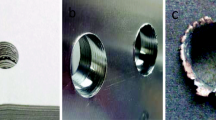Abstract
In milling, burrs are formed on entry and exit edges of the workpiece to be machined like in all material removal processes. In the subsequent production these burrs have to be removed. Understanding the influencing factors and burr formation mechanisms can help to avoid or reduce burrs. Another possibility for saving costs is to reduce the process materials, for example, cutting fluids. This can be realised by using minimum quantity lubrication or dry machining. The investigations show which influence both methods have on burr formation.



















Similar content being viewed by others
References
Herzhoff P (2003) Trockenbearbeitung und Minimalmengenschmierung beim Wälzfräsen mit HSS-Werkzeugen. Dissertation Otto von Guericke Universität, Magdeburg
N.N. Trockenbearbeitung in der Praxis, Landesgewerbeamt Baden-Württemberg 2004
Weinert K (1999) Trockenbearbeitung und Minimalmengenkühlschmierung Einsatz in der spanenden Fertigungstechnik. Springer, Berlin
Schäfer F (1976) Untersuchungen zur Gratbildung und zum Entgraten insbesondere beim Umfangsstirnfräsen, Dissertation Universität Stuttgart
Dornfeld DA, Avila MC (2004) On the face milling burr formation mechanisms and minimization strategies at high tool engagement. Consortium on deburring and edge finishing. University of California, Berkeley
Dornfeld DA, Shefelbine W (2004) The Effect of Dry Machining on Burr Size Consortium on Deburring and Edge Finishing. University of California, Berkeley
Dornfeld DA, Avila M (2003) The effect of kinematical parameters and tool geometry on burr height in face milling of Al–Si alloys consortium of deburring and edge finishing. University of California, Berkeley
Aurich JC (2006) SpanSauber, Untersuchung zur Beherrschung der Sauberkeit von zerspanend hergestellten Bauteilen, Ergebnisworkshop, Lehrstuhl für Fertigungstechnik und Betriebsorganisation, Technische Universität Kaiserslautern
Dornfeld D, Min S, Reich-Weiser C (2004) Burr Formation, Deburring & Surface Finishing, 7th International Conference on Deburring and Surface Finishing, Berkeley
Dornfeld DA, Kim JS, Dechow H, Hewson J, Chen LJ (1999) Drilling Burr Formation in titanium alloy, Ti-6Al-4V. CIRP Ann 48(1):73–76. doi:10.1016/S0007-8506(07)63134-5
Schäfer F (1992) Grundlagen zur Lösung von Entgratproblemen, Entgrat-Technik, Entwicklungsstand und Problemlösungen, Reihe Kontakt und Studium. Oberflache 392:33–42
Heisel U, Luik M, Schaal M (2005) Berechnung der Gratgrößen beim Kurzlochbohren. Spanende Fertigung 4:123–131
Olvera O, Barrow G (1998) Influence of exit angle and tool nose geometry on burr formation in face milling operations, Proceedings of the Institution of Mechanical Engineering B. J Eng Manuf 212(1):59–72
Rangarajan A, Dornfeld DA (2004) Back cutting and tool wear influence on burr in face milling—analysis and solutions consortium on deburring and edge finishing. University of California, Berkeley
Acknowledgments
This research was conducted within the framework of a project supported by the German Research Foundation (DFG).
Author information
Authors and Affiliations
Corresponding author
Rights and permissions
About this article
Cite this article
Heisel, U., Schaal, M. & Wolf, G. Burr Formation in milling with minimum quantity lubrication. Prod. Eng. Res. Devel. 3, 23–30 (2009). https://doi.org/10.1007/s11740-008-0138-9
Received:
Accepted:
Published:
Issue Date:
DOI: https://doi.org/10.1007/s11740-008-0138-9




